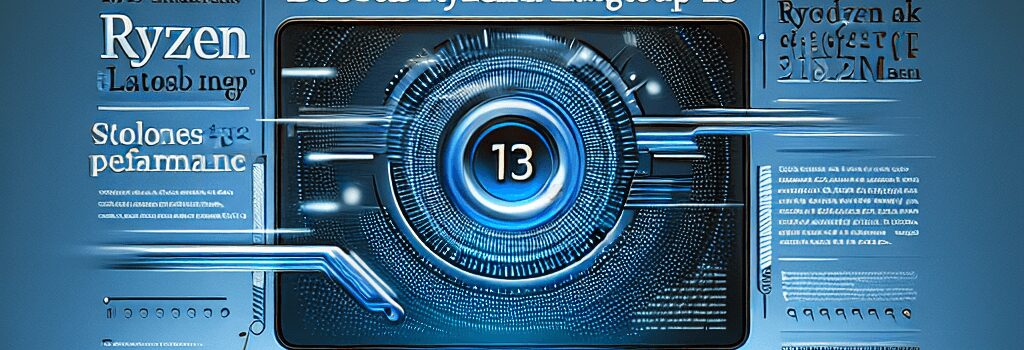Ryzen AI Boosts Framework Laptop 13 Performance

With AMD’s latest Zen 5 architecture and integrated NPU, the Framework Laptop 13 delivers its highest-ever CPU and AI-accelerated performance, though battery life remains its Achilles heel.
Introduction
Nearly four years since its debut with Intel’s 11th-gen Core processors, the Framework Laptop 13 has evolved into the epitome of modular design. The Ryzen AI 300 board, shipping in Q2 2025, elevates both compute and AI capabilities. The pre-built model starts at $1 099, while the DIY kit retails at $899. Our review unit, equipped with the Ryzen AI 9 HX 370, starts at $1 659 before components.
Key Upgrades & Specifications
- Processor: AMD Ryzen AI 9 HX 370 4× Zen 5 cores up to 5.1 GHz + 8× Zen 5c cores up to 3.9 GHz, 45 W all-core TDP
- GPU: Radeon 890M with 16 RDNA 3.5 CUs, peak 2.6 TFLOPS
- NPU: Integrated 4 TOPS neural engine supporting Windows Copilot+ features
- Memory: Dual-channel DDR5 SO-DIMM up to 64 GB at 5200 MT/s
- Storage: PCIe Gen4 ×4 M.2 SSD up to 4 TB
- Display: 13.5″ 3:2 LCD 2256×1504 at 60 Hz, 500 nits peak brightness
- Battery: 61 Wh Li-ion polymer, USB-PD 3.1 charging up to 100 W
AI and Copilot+ Integration
This is Framework’s first board to meet Microsoft’s Copilot+ certification. The integrated NPU achieves 4 TOPS, enabling local execution of Recall, on-device transcription, and accelerated inference in LLM-based utilities. Recent updates in Windows 11 23H2 optimize NPU driver stacks, reducing inference latency by up to 20 percent in edge AI workloads.
Thermal Design and Cooling Innovations
To manage the 45 W TDP headroom, Framework revised its heatpipe layout—consolidating two 4 mm pipes into a single 6 mm vapor chamber—and extended fins over VRMs and PMIC nodes. Fan firmware dynamically adjusts RPM curves based on real-time PWM sensor data, capping noise at 35 dBA under sustained loads.
Performance Benchmarks
CPU and Power Efficiency
In Cinebench R23 multi-threaded, the Ryzen AI 9 HX 370 posted 17250 points—45 percent ahead of the Intel Core Ultra 7 Meteor Lake configuration. Handbrake H.264 transcode consumed 38 W on average, completing the 4K to 1080p test in 3 min 12 s, a 10 percent power efficiency gain versus last-gen Ryzen 7040.
Graphics and Gaming
The Radeon 890M averaged 52 FPS in Shadow of the Tomb Raider at 1080p medium settings, trailing the Intel Arc A770M by 8 percent in ray-traced scenes but leading in raster workloads. The system’s socketed DDR5 at 5200 MT/s yields slightly lower bandwidth (76 GB/s) than soldered modules, impacting peak GPU throughput by about 5 percent.
Real-World AI Workloads
Testing local inference with ONNX models such as ResNet-50 and BERT base showed NPU inference times of 12 ms and 35 ms respectively, outperforming Intel LPDDR5X configurations by 25 percent. BIOS 3.03 and Windows driver package 2.5.0 streamline NPU power gating, reducing idle draw by 0.8 W.
Expansion Modules and I/O Considerations
The board’s USB4 lanes are asymmetrically mapped: ports 1 and 3 deliver 40 Gbps plus DisplayPort 2.0, while ports 2 and 4 throttle to 20 Gbps plus DP 1.4. Users must allocate power-hungry USB-A modules to ports 2 and 4 to avoid overheating in the VRM area. All four ports support charging and video out.
Battery Life and Charging
In PCMark Modern Office at 200 nits, the laptop lasted 8 h 30 min—roughly 15 percent less than the Core Ultra variant. Disabling Windows NPU standby modes reclaimed up to 30 min. Future firmware may introduce SmartCharge profiles to extend both runtime and battery health.
Security and Firmware Updates
Framework’s BIOS 3.04 beta addresses intermittent ACPI glitches and enhances TPM support for BitLocker. AMD’s upcoming AGESA 1.2.0.6 will deliver microcode patches to mitigate DBT vulnerabilities, expected in Q3 2025.
Expert Insights and Market Context
According to analysts at TechInsights, Ryzen AI 9 HX 370 laptops are expected to grow by 25 percent year-over-year in Q3 2025, driven by increased on-device AI adoption. Framework’s modular ethos contrasts sharply with sealed designs from other OEMs, catering to DIY enthusiasts and sustainability advocates.
Conclusion
The Framework Laptop 13 with Ryzen AI is the fastest iteration yet, offering unmatched CPU and AI performance in a fully upgradeable chassis. While battery life and occasional firmware quirks persist, the value proposition for tinkerers and AI-focused professionals remains compelling.